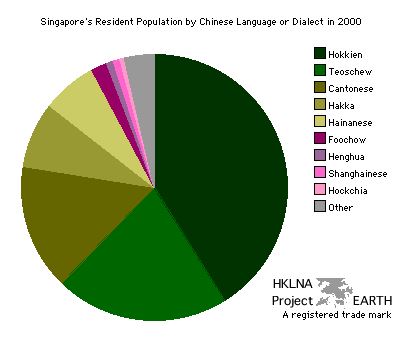Graph 72 - Singapore's Chinese ethnic
resident population by Chinese language or dialect in 2000.
graphs 51a
and 51b | graphs 69a and 69b | graphs 70a and 70b | graphs 71b and 71c | collection
index (graphs)
|

|
Note 1: This chart
includes only non-Mandarin languages and dialects and was created from
data obtained from the Singapore Statistics Department (see data
source below). The department does not distinguish between language
and dialect in its report and labels everything as dialect.
Labeling everything as dialect is not wrong, but failing to distinguish
between dialect and language is very misleading, as it makes it appear
that everyone speaks the same language. For most Singaporeans learning
Mandarin means learning a second language. It is somewhat akin to a
Korean studying Japanese, but without having to learn the Japanese
alphabets (hiragana and katakana)
|
Note 2: Ethnologue's
method of reporting linguistic data for Singapore and the Singapore
Statistics Department's method of reporting differ considerably. In
order to compare the data shown in graphs 51a and 51b with that provided above, the
following guide obtained from Ethnologue is useful:
- Hokkien (dialect of Min Nan)
- Teochew (dialect of Min Nan) - misspelling in pie
graph
- Cantonese (another name for Yue)
- Hakka (same as ethnologue)
- Hainanese (dialect of Min Nan)
- Foochow (another name for Min Dong)
- Henghua (another name for Pu Xian)
- Shanghainese (not listed in the Ethnologue study)
- Hockchia (another name for Min Bei)
- Min Bei = Hockchia
In the end only Hokkien, Teochew, and Hiananese are
mutually intelligible dialects of the same language. Together they
represent a language quite different from Mandarin --
the Singapore government's mother tongue for all
ethnic Chinese residents!
|
| Data Source: Singapore Government.
Department of Statistics. Statistics Singapore. Papers
and Anaylses. Population. Profile of the Singapore Chinese dialect
groups. Chart 1, p.2. [online document - pdf 20 KB] (March 2004).
Alternatively [EARTH's online
copy - PDF 20 KB]. Copy of data in EXCEL format also available
upon special request.
|
